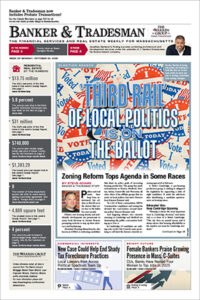Commercial real estate professionals hoping for some heat to thaw frozen capital markets are looking across two oceans for signs of life.
Even as commercial defaults mount nationwide, developers and economists are cautiously optimistic about the comparative strength of the Greater Boston market, compared to markets in Europe and Asia. The hope is that a number of macroeconomic factors will drive the flow of investment dollars into local properties, speeding recovery.
At a recent NAIOP forum, Dr. Jeffrey Fuhrer, director of research at the Federal Reserve Bank of Boston, said, “Europe doesn’t look so good. They’ve been relatively slow to respond to the crisis, and theirs is at least as big as ours.”
Because of the different speed of response in the U.S. and Europe, Fuhrer predicted, “Flows of assets are more likely to flow into the U.S. than Europe.”
Matthew Galligan, head of American property finance at the Bank of Ireland, made a similar prediction at a recent Urban Land Institute forum.
“Equity dollars will come because the [European] recession will last longer,” he said. Galligan anticipates a flow of European equity investment into American commercial properties because commercial’s future looks comparatively brighter on this side of the Atlantic.
‘More Penetration’
Boston should be poised to capture a healthy portion of that investment because the city isn’t flooded with excess supply, thanks to high barriers to entry and a relatively stable financial services sector.
Galligan added, “If European buyers come, the debt will follow.” He noted that the Bank of Ireland is “positioned for more penetration in the U.S.”
Greater Boston’s investment sales market badly needs a shot in the arm. Sales of office properties plummeted from $9.95 billion in 2007 to $1.35 billion in 2008, according to data from CBRE. Sales ground to a near-total halt in the year’s final quarter, and have remained flat on the ground since then.
The area’s largest sales transaction came when the John Hancock Tower fell to foreclosure auction after its former owner defaulted on the building’s mezzanine debt. Troubled Corus Bank was virtually uncontested at auction when it took back the distressed office shell at 441 Stuart St. in Boston for $17 million last month. Tewksbury’s Ames Pond Corporate Center traded for $10 million in April – a nearly $9 million haircut from the building’s last sale. In January, 325 Donald Lynch Blvd. in Marlborough traded for $6.6 million. And German insurer Allianz Group took a 50 percent stake in Boston’s One Beacon St., closing a deal that had been in the works for several months.
The year’s biggest non-distressed sale came in January, when National Development and Charles River Realty Investors scooped up 10 Brookline Place in Brookline for $62 million.
The Beginning Of The End?
The migration of European investment may already be beginning. Reports have GLL Real Estate Partners, a German equity firm, purchasing One Winthrop Sq. in Boston from RREEF Real Estate, the proeprty investment arm of Deutsche Bank’s asset management division, for $21 million. Last year, GLL purchased two Boston office buildings – 200 State St. and 70 Franklin St. – for $167 million and $36 million, respectively.
Gale International’s John B. Hynes III recently said that two separate groups of investors had cold-called him, looking to sink equity into his stalled Filene’s redevelopment project. The investors have sizable holdings in Treasury bills, and were looking to invest in real estate as a hedge against inflation in the American economy, he said.
Both groups, Hynes said, were primarily interested in the site’s residential potential. Their interest was a driving factor in Hynes’s recent decision to redesign the stalled Downtown Crossing tower and reinsert 250 luxury residential units into building plans.






